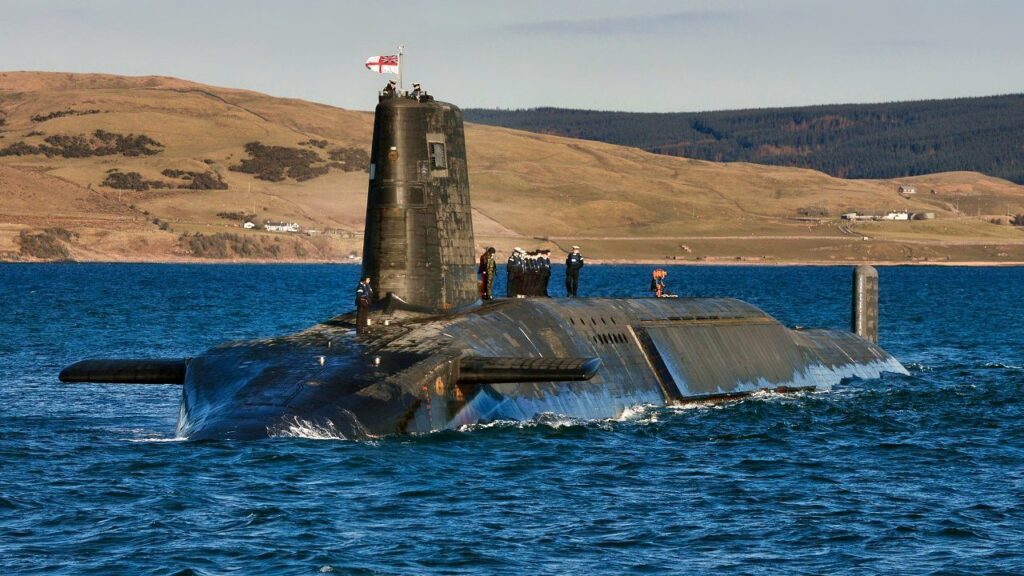Summy and 4 Points You Need to Know About this Submarine: The British Royal Navy’s Vanguard-class submarines, introduced in the 1990s, serve as the core of the UK’s seaborne nuclear deterrent. It was built for a nuclear war against Russia or any enemy of the UK.
-These stealthy subs, designed for extended underwater missions, carry Trident II D5 ballistic missiles, each equipped with multiple nuclear warheads.
-While the Vanguard-class represents top-tier engineering and provides a credible sea-based nuclear deterrent, the Royal Navy’s overall decline in capabilities, exacerbated by underfunding and strategic mismanagement, undermines the force’s readiness.
-With their replacements, the Dreadnought-class, not expected until the 2030s, the Vanguard-class will remain in service longer than intended, potentially overextended.
Inside Britain’s Vanguard-Class Subs: A Closer Look at Nuclear Stealth
Back in the 1990s, the British Royal Navy needed to upgrade their nation’s nuclear triad. As an aside, a nuclear triad is what most advanced countries with nukes prefer to have as a redundant strike capability. Essentially, this means that the country in question has the ability to launch nuclear weapons from land bases, from the air, and from warships at sea. Specifically, submarines.
The Royal Navy procured the Vanguard-class submarine as their primary seaborne nuclear deterrent.
Vanguard-Class Submarines: The Specs
In many respects, the Vanguard-class represented the apotheosis of British naval engineering, stealth capabilities, and strategic deterrence. Since 1993, they have been the basis of Britain’s submersible capabilities.
Designed with an iconic teardrop hull-shape that reduces hydrodynamic noise, these subs have anechoic tiles that absorb sonar pulses. In essence, these boats are rendered nearly invisible to sonar detection, making them a potent—and fearsome—weapon.
These boats are approximately 150 meters long and displace approximately 16,000 tons when submerged. The Vanguard-class carries crew of around 135 sailors.
A PWR2 (Pressurized Water Reactor 2) nuclear reactor powers these submarines. They can remain submerged for extended periods. The nuclear reactor on the boat adds to the submarine’s stealthiness because it allows for the submarine to remain submerged for protracted periods. Non-nuclear subs, for example, are required to snorkel that allows for the enemy to detect them while snorkeling.
Britain’s HMS Vanguard, the first of her namesake, was launched in 1993. She was intended to replace Britain’s long-serving (since the 1960s) Resolution-class submarines. The HMS Victorious, HMS Vigilant, and HMS Vengeance followed in short order.
Her Primary Weapon
The Trident II D5 ballistic missile is the Vanguard-class submarine’s primary weapon. This missile can carry multiple independently targetable reentry vehicles (MIRVs). A single Vanguard-class carries 16 of these Trident II D5 ballistic missiles. Each of these missiles can carry a whopping eight nuclear warheads.
Thus, the Vanguard-class submarines give Britain what it wanted: a reliable and credible nuclear weapons capability at sea. Britain has a strong sea-based nuclear deterrent, meaning that it has a significant nuclear triad. Even if her land and air nuclear weapons capabilities are lost in war, the seaborne capability will be harder to destroy—especially given the Vanguard-class submarine’s impressive stealth capabilities.
The Sad State of the British Royal Navy
All this being said, sadly, the Royal Navy has seen better days.
For years, the decline in their once-mighty capabilities has been severe. Some decline in capability is to be expected for a country like Britain, that surrendered her once-globe-spanning empire and became regional power isolated to the North Atlantic.
Although, the decline has gone beyond what could have been expected.
The quality of seamanship has degraded. Chronic underfunding has gutted the British military in general. What’s more, a lack of strategic vision from the country’s leaders—notably in the post-Cold War era—have further eroded the readiness of the British military. Whatever funds are made available to the Royal Navy tend to go into irresponsible vanity projects, such as the massively expensive Queen Elizabeth-class aircraft carriers (there are two in service today).
In fact, as I reported in these pages, the HMS Vanguard herself has been involved in embarrassing flaps that no serious navy would have tolerated. Notably, back in 2009, the Vanguard collided undersea with a French submarine while on patrol. Subsequent (covered-up) investigations showed that improper communication, malfunctioning equipment, and poor seamanship on the part of the Royal Navy crew and leadership nearly led to the loss of the British nuclear sub.
The bottom line is that, for all the technical skill that went into creating the Vanguard-class, for all the deterrence these boats give the British Royal Navy, with the entire force in general decline, none of that really matters.
What Happens Next to Vanguard-Class?
Still, the Vanguard-class is an excellent bit of engineering.
Made all the more remarkable by the fact that her replacement, the Dreadnought-class SSBN, won’t be ready until at least the 2030s—meaning the Vanguard-class will be on call for much longer than what her designers originally intended.
In fact, the Vanguard class will have served far longer than even her legendary predecessor, the aforementioned Resolution class, ever did.
Author Experience and Expertise: Brandon J. Weichert
Brandon J. Weichert, a National Interest national security analyst, is a former Congressional staffer and geopolitical analyst who is a contributor at The Washington Times, the Asia Times, and The-Pipeline. He is the author of Winning Space: How America Remains a Superpower, Biohacked: China’s Race to Control Life, and The Shadow War: Iran’s Quest for Supremacy. His next book, A Disaster of Our Own Making: How the West Lost Ukraine, is due October 22 from Encounter Books. Weichert can be followed via Twitter @WeTheBrandon.
All images are Creative Commons or Shutterstock.
From the Vault
Russia Freaked Out: Why the U.S. Navy ‘Unretired’ the Iowa-Class Battleships
Battleship vs. Battlecruiser: Iowa-Class vs. Russia’s Kirov-Class (Who Wins?)
Source link : https://nationalinterest.org/blog/buzz/not-made-usa-vanguard-class-stealth-missile-submarine-has-1-mission-212554
Author :
Publish date : 2024-09-04 01:07:00
Copyright for syndicated content belongs to the linked Source.
